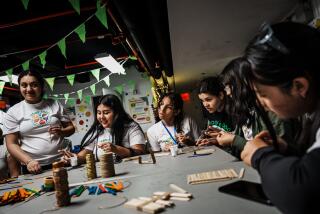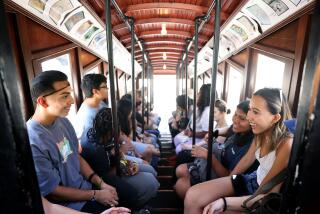Getting Personal With History
Not long ago, 16-year-old Jessica Gutierrez knew what most people know about Cesar Chavez: He did something with unions and farm workers and grapes, and he marched around with a black-and-red eagle flag, chanting, âSi, se puede (Yes, we can).â
How that related to her didnât really matter -- until this year.
Now the junior is enrolled in a Mexican American studies course at Century High School in Santa Ana, a groundbreaking class that she says has changed her life.
It is a class that Santa Ana educators have introduced to schools around the United States.
On Saturday, Jessica, her teacher, George Aguirre, and many of her classmates were at Cesar Chavez Campesino Park in Santa Ana to mark the labor organizerâs birthday and honor his contributions to improving the lives of farm workers.
Jessica helped organize the event, which included political speeches, medal presentations to local soccer teams, music and colorful ballet folklorico. She is inspired to work in the community now, she said, largely due to her class.
âItâs so indescribable,â Jessica said. âItâs just a great experience for me. It has opened my mind and expanded my knowledge about my roots.â
Her classmate Alexandra Escobedo, 17, speaks with the same enthusiasm.
âI used to go home after school and watch TV,â Alexandra said.
Now, she stays after school, working with clubs and organizing school events such as Mexican Day for Centuryâs International Week celebration.
âI want to make the world better,â she said, âget teenagers together and make them do something to help the community.â
Their teacher believes it would have made Chavez proud. This is his legacy, speakers at Saturdayâs event said: inspiring others to get involved, make a difference and become leaders.
Aguirre has been teaching the Mexican American studies class since the program began districtwide five years ago.
Now he and others, including local activist Seferino Garcia, are trying to spread their program elsewhere.
They will discuss the class this week in Los Angeles at the annual conference of the National Assn. for Chicana and Chicano Studies.
Educators there are hoping to push legislation to implement Chicano studies in elementary and high schools.
Aguirre doesnât need to say much. His students say it for him. But he does note what they are like when they come to him at the beginning of the school year.
âTheyâre clueless,â Aguirre said. âThey donât know the difference between Halloween and Dia de los Muertos. They know something about Pancho Villa -- vaguely.â
In the year they are in his class, students spend the first semester immersed in Mexican American history. The second semester is devoted to Mexican American literature and texts more often found in college classrooms.
âWe shouldnât wait for college for these students to gain this urgency,â Aguirre said. âThis gets them zoned in, focused on the future.â
Juan Ozuna teaches at Cesar Chavez High School in Santa Ana, where he is struggling to keep his elective Mexican American studies class afloat.
âIt should be mandatory,â Ozuna said, especially in a district where a majority of the population is Latino.
âIt is a vehicle for higher education. When the kids are energized and learn about their culture, thereâs spillover into reading and writing and also into the community.â
More to Read
Sign up for Essential California
The most important California stories and recommendations in your inbox every morning.
You may occasionally receive promotional content from the Los Angeles Times.











